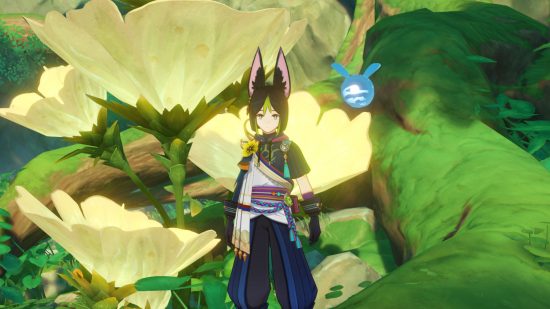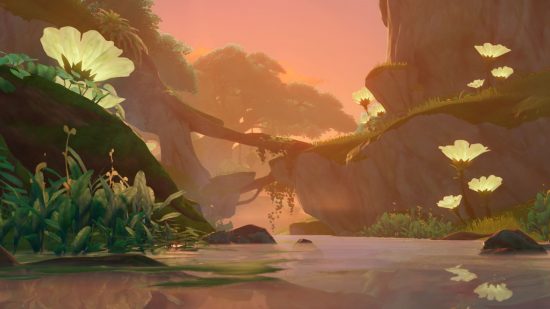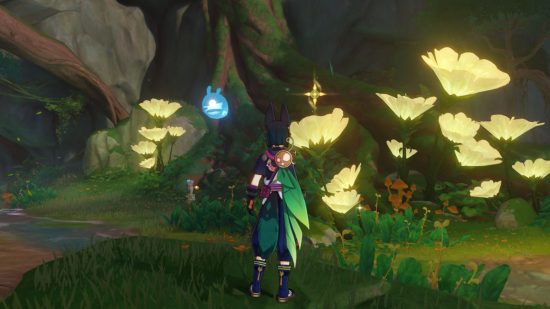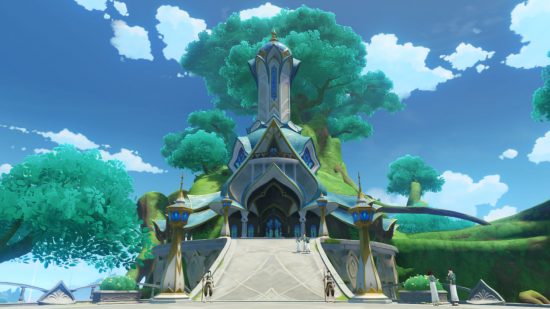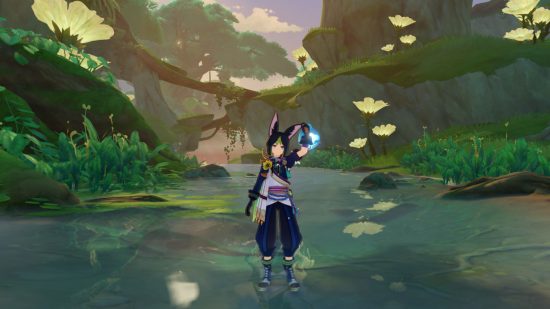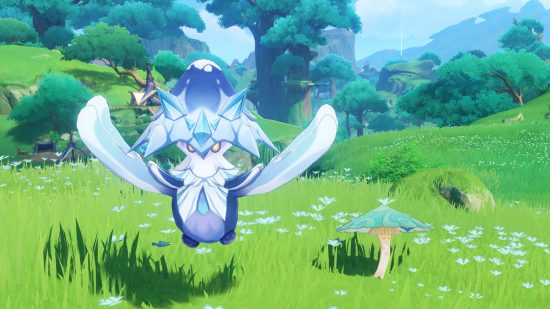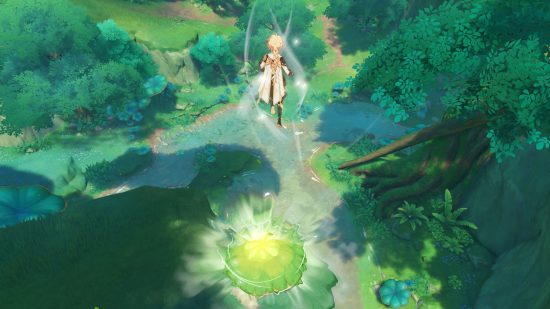We’ve all been waiting eagerly to visit the verdant green forests and luscious lands of Genshin Impact’s Sumeru for longer than we’ve been waiting for a Tartaglia rerun. With all of Hoyoverse’s drip marketing, snippets of lore tucked away in the most unlikely of places, and a cataclysmic amount of leaks slipping through the cracks, the hype has never been higher. Now, Sumeru is finally here, and I’m pleased to say it lives up to all of my expectations.
A new nation coming to Genshin Impact almost feels like a worldwide holiday at this point, as those of us who picked every square inch of Inazuma, Liyue, and Mondstadt clean impatiently await a fresh area to explore, characters to snag, and exciting stories to delve into. This time, the excitement is further amplified by the addition of dendro, offering brand new elemental interactions to explore and finally completing Genshin Impact’s original seven-element system.
During the Genshin Impact Sumeru preview, Hoyoverse granted me access to all landscapes, world quests, and archon quests available for 3.0, as well as being given free rein in the dense rainforests of Sumeru and multiple settlements within, including Sumeru City and Port Ormos, with new characters Collei and Tighnari. However, I didn’t have access to Sumeru’s deserts, seasonal events and banners, or characters coming to later updates, so I can’t comment on any of that.
It should come as no surprise that Sumeru is absolutely breathtaking. With the second teaser trailer, we saw environment artist Jux Huan talk about the design process, and got a glimpse of the stunning nation coming into full bloom, showcasing the love and attention put into the development of the new region. But that still didn’t prepare me for just how jaw-droppingly gorgeous the land is.
The moment you step out of the familiar darkness of the Chasm’s tunnel into the vibrant, luscious foliage of the forest, you feel the overwhelming difference between Sumeru and the previous nations we’ve explored so far. The flora and fauna are entirely unique, with huge, blossoming flowers illuminating the land, and twisting tree roots shaping the landscape.
The new endemic life, from the skittering lizards to the mossy boars with mushrooms growing atop their backs, are beautifully designed, and add a true sense of life to every square inch of the map. Even the shapes of the rock formations and cliffs are notably different, giving Sumeru a true sense of identity and making it genuinely feel as though you’re in a different country. However, Sumeru still carries that classic Genshin Impact charm, and doesn’t feel disjointed from the rest of the map.
Throughout the forest, you feel entirely enshrouded in nature, with even the settlements and villages snuggled perfectly in amongst the trees and plants. There are towering trunks, sheer drops, cascading waterfalls, and curving cliffs everywhere, but, thanks to the four-leaf sigils floating around, traversing them is a breeze. These little beauties allow you to zip from place to place with ease, almost like a slingshot mechanic, offering a fast transportation method that also gives you a stunning view of the land around you.
I won’t go into too much detail about the story and side quests to avoid spoilers, but it immediately plunges you into a world of mystery and intrigue. In fact, from what I’ve played up to this point, I’d go so far as to say it’s my favourite Archon quest line to date.
As with previous nations, Sumeru’s plot takes inspiration from elements of folklore, legends, and culture It then shapes them to fit with the game’s overarching narrative, mixing in its own sense of magic to make something truly unique. Honestly, I can’t get enough of it. The presence of the adorable forest spirits, the ever-looming threat of the Fatui Harbingers, the history surrounding the dendro archon, and the significant influence of Sumeru Akademiya all enrich the story wonderfully, and highlight the amount of attention and care that Hoyoverse has put into Genshin’s worldbuilding and lore since the very beginning.
Those of you who are familiar with the Genshin Impact manga will be glad to know that the archon quest revisits Collei and explains where she’s been since her stay in Mondstadt. It also takes a closer look at her affliction and how it affects her daily life. As someone with past trauma and chronic illness myself, I’ve always felt close to Collei, and I find the handling of her story to be powerful yet tactful. In fact, it moved me deeply, and I’m not ashamed to admit it had me in tears as I empathise with her so closely, which only shows just how well-developed she is.
Collei is a very strong character with an extremely interesting backstory, so it’s great to see her finally get her time to shine, and I can’t wait to see it develop further. I’m also delighted by Tighnari, who comes across as somewhat coarse at first, but shows his kind yet dutiful nature through his care for Collei, the people of Gandharva Ville, and the flora and fauna he watches over.
When it comes to gameplay, Sumeru offers plenty of the same exploration and combat you’ve come to know and love, with the addition of new, exciting mechanics to keep it fresh. From bouncing on mushrooms to cleansing dangerous Withering Zones, it’s wonderful to see the environment used so inventively, and there’s plenty of new features to explore and acquaint yourself with.
Of course, we also have the new dendro element. We’ve all been looking forward to this, and I can safely say it doesn’t disappoint me in the slightest. As mentioned above, during the preview I had access to Tighnari and Collei, and could also align the Traveler with dendro, and I had an absolute blast experimenting with them.
It’s pretty clear that dendro is unique in that most of its damage comes from its elemental interactions – and therein lies the fun. There are three basic reactions called burning, bloom, and catalyze. Bloom is easily my favourite, as you can add in yet another element for further reactions, allowing you to experiment and explore some really fun effects.
There are heaps of enemies to test these new interactions on, too. Some familiar critters make reappearances, but there are plenty of region-specific baddies to get acquainted with, including mushroom-like creatures, Heremites in place of treasure hoarders, and more. Their attack patterns and weaknesses are familiar enough that taking them on feels intuitive, while still offering some variety to keep you entertained.
As is expected, the Sumeru OST is sublime. Genshin Impact is well known for its stunning musical scores, and the new nation is no exception. From the whimsical wind instruments that play as you wander around the luscious landscapes to the vibrant crescendos that ring out as you plunge into battle, each track is expertly composed and perfectly compliments both the situation at hand, and the overall feel of the region.
Genshin Impact has been one of my favourite games for some time now. However, being stuck in that familiar, event and resin-dictated endgame cycle was lumbering me with a sense of burnout, as it has with many of you. Luckily, getting a taste of Sumeru has shown me that there’s still plenty of life left in this wonderful title, and has reignited my passion for exploring Teyvat. I hope that Genshin will keep growing, expanding its world while taking on board the feedback of its ever-passionate fanbase.
Genshin Impact’s Sumeru is a wonderful way to continue the legacy of this industry-changing game, and now I simply can’t wait to dive back into the new expansion and see what other players think. See you in the forest, fellow Travelers.
